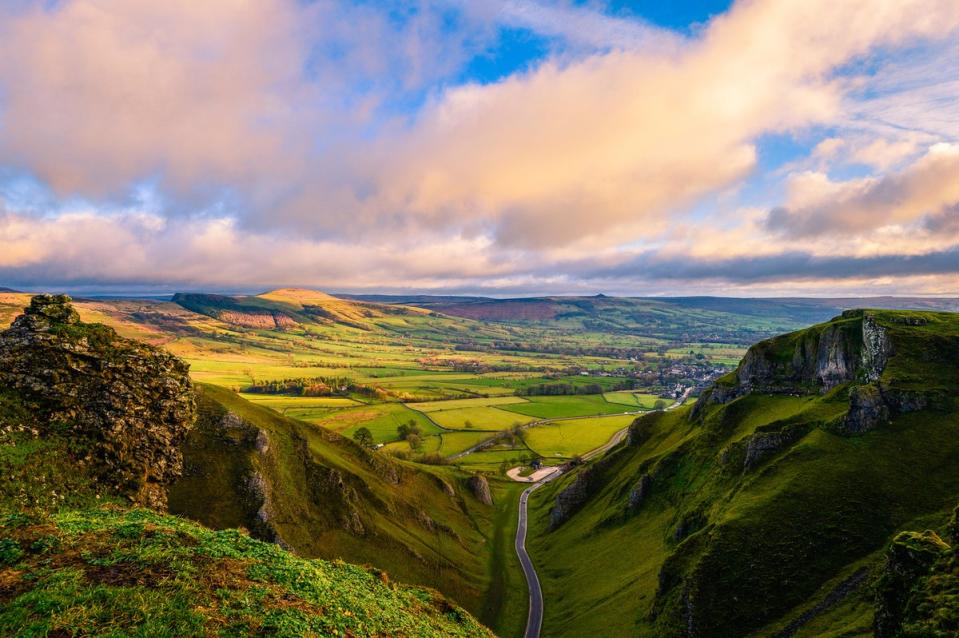I visit the Peak District at least once a month – here’s how to do it without a car

The Peak District’s 555 square miles of moorland and valleys has just one town, Bakewell, yet – even more surprising – still manages to be well-served by public transport.
Located between Sheffield and Manchester, a single train or bus can get you everywhere from the pudding shops of Bakewell (tarts also available) to the grandeur of Chatsworth House and the elegant mid-century designs of David Mellor at the eponymous visitor centre in Hathersage.
It celebrates the work of the man responsible for urban design classics including the Plexiglas ‘Abacus’ bus shelters of my youth, and the humble traffic light, unchanged since its 1965 Mellor redesign.
Of course, such attractions invariably offer parking, but with their increasing popularity comes a host of major traffic issues. Visitors arriving by car over the Easter bank holiday weekend managed to cause gridlock on Winnats Pass, usually one of the country’s most idolised roads, in their search for parking spots amid country lanes and dry-stone walling – and at the same time, motorists created enough of the pollutant nitrogen dioxide to shame many inner-city A roads.

Read more on UK travel:
Best Cornwall walks: From coastal routes to countryside ambles
How to spend a day in the Baltic Triangle, Liverpool’s ultra-cool creative district
So as the sun begins to penetrate the winter gloom, it’s high time to ditch the one-litre runaround for a 15-litre bus engine (or its electric equivalent). You’ll rarely wait more than an hour for either bus or train.
Even before its current upgrade began, Northern Rail would get you down the Hope Valley line from Sheffield to Grindleford (for Padley Gorge and the Longshaw Estate) in less than 15 minutes, costing the princely sum of £5.10 for a standard single ticket. The line reaches as far as Manchester Piccadilly, by way of some of the Peak District’s most-celebrated landscapes.
At Hathersage, just three minutes further down the tracks, the David Mellor Visitor Centre is joined by the burial place of Robin Hood’s Little John in St Michael’s churchyard and vistas that inspired Charlotte Bronte while she was writing Jane Eyre,including Stanage Edge (a two-mile walk away). A glorious gritstone escarpment, popular with rock climbers and hikers whatever the north’s weather is doing (which is often a lot), its natural beauty is only bettered by the open panoramas carrying across the Dark Peak moorland back along the Hope Valley. Head there early on a weekday, and you’ll likely share its magical ambience with just a handful of other weatherproof souls dotted about its four-mile length.

The valley and its rail line are named after Hope, the sort of village worth lingering in for its numerous cafés of the cakes-freshly-baked-on-the-premises variety, old-world respectability (not only are there public toilets, but they’re free) and a decent crop of pubs rich in regional ales and tempting beer gardens – all the more appealing when you visit without the car.
Should energy levels wain, and the rail stations at Hope or Edale (start of the Pennine Way, the UK’s third-longest hiking route at 267 miles) seem a step too far, Castleton is the western terminus of the 271/272 bus back to Sheffield. When boarding the double-decker variety, be sure to head upstairs to continue your view-laden journey.
The same applies to the 218, connecting Sheffield with Bakewell via Chatsworth House in an hour, should the route’s slightly anarchic view on the importance of timetables not dismantle plans, in which case the 257 does the job similarly well via the ‘plague village’ of Eyam.

Meanwhile, the seasonal open-top Peak Sightseer has morphed into two routes for the first time this year, linking Chatsworth with either Bakewell and Ashford in the Water or Blue John Cavern (entry £19), one of only two places in the world where the semi-precious mineral of the same name is mined, via the Hope Valley.
Services from Manchester are less comprehensive, but you can get the 58 from Macclesfield to Buxton in around 30 minutes, with occasional buses continuing to Chatsworth. A better option is the train from Manchester Piccadilly to Buxton via Stockport, attractive little New Mills and walks around Whaley Bridge. Encircled by, but not in, the national park, Buxton’s fondness for wellness and spa-based retreats is another reason to avoid raising the heart rate by doing away with the bother of driving.
Where to stay
Alongside hotels in Sheffield and Manchester, there’s amply accommodation within Peak District National Park including the handful of classic en suite rooms at The Scotsman’s Pack Country Inn, Hathersage (from £95, two people sharing); Hope’s dog-friendly Bike & Boot (from £102) and the individually styled boutique bedrooms of Bakewell’s The Ashford Arms (from £100).
How to do it
The Sheffield-Manchester Hope Valley line runs hourly, stopping at 13 intermediary stations including Grindleford, Hathersage, Hope and Edale. It’s operated by Northern (tickets from £5.10) alongside the Manchester-Buxton line.
Bakewell is a hub for buses, including the 218 and 257 from Sheffield via either Chatsworth House or Eyam; single adult fares are £2 until 31 December 2024. Have your English Heritage membership to hand for Castleton’s Peveril Castle (otherwise £8.10).
From 11 May until 6 October daily, Stagecoach runs Peak Sightseer red (Chatsworth House to Bakewell) and blue (Chatsworth to Blue John Cavern) bus routes every 30 minutes at peak times (day ticket with unlimited travel £9.50).
Read more: How to do the Lake District car-free

 Yahoo News
Yahoo News 
